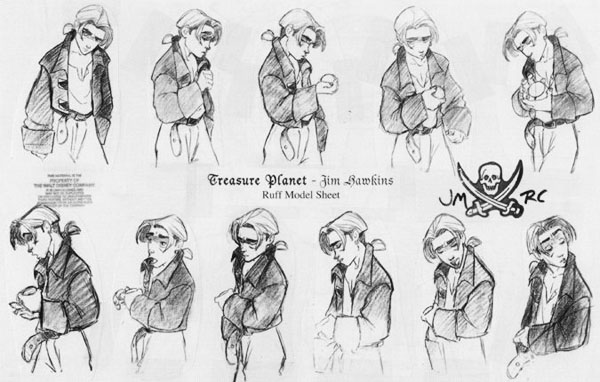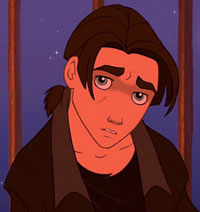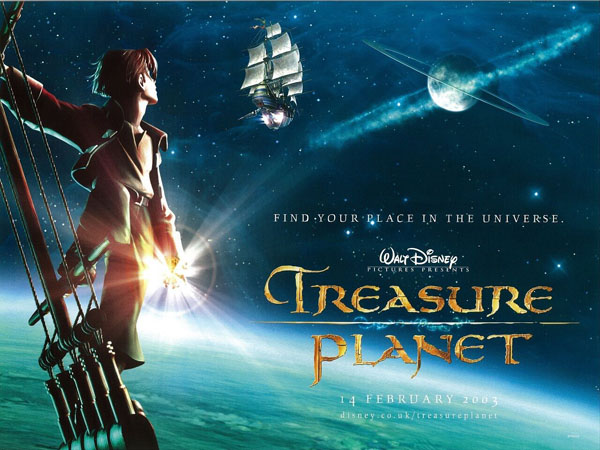SUSPENDED ANIMATION #241

In 1985, CEO Michael Eisner and Disney chairman Jeffrey Katzenberg initiated the first Disney animation Gong Show where people could pitch ideas for animated feature films.
Animation director Ron Clements remembered, “I had recently read The Little Mermaid in a bookstore and got excited, so I wrote a two-page treatment for it. I’d written up a two-page treatment for Treasure Island in Space, as well.”
Katzenberg firmly rejected both ideas but later re-evaluated The Little Mermaid that he had initially felt was too similar to the forthcoming live action film Splash and put it in production.
Clements along with John Musker who he had been recently partnered with pitched the Treasure Planet idea two more times over the years before finally in 1995, during the production of Hercules, Clements and Musker signed a seven-year contract deal with Disney that stipulated following their work on Hercules, the studio would produce Treasure Planet or another project of their choosing.
 Basically, there are three different forms of animation in Treasure Planet (2002). The characters for the most part were done using hand drawn animation. Silver’s mechanical items, B.E.N. (voiced by comedian Martin Short and animated by Oskar Urretabizkaia) and some alien creatures were done using CGI. The sets and background utilized Deep Canvas and Virtual Sets.
Basically, there are three different forms of animation in Treasure Planet (2002). The characters for the most part were done using hand drawn animation. Silver’s mechanical items, B.E.N. (voiced by comedian Martin Short and animated by Oskar Urretabizkaia) and some alien creatures were done using CGI. The sets and background utilized Deep Canvas and Virtual Sets.
While most of the characters in Treasure Planet were completely hand-drawn, the character of John Silver was a hybrid of traditional animation and CGI. Musker explained, “It was challenging because the character had to be created twice. It was almost like having two characters.”
Disney Legend Glen Keane would do the 2-D animation for Silver, but Eric Daniels animated the mechanical pegleg, the cyborg arm where a different selection of devices would rotate into place when needed and an eye used as a targeting mechanism and the ability to scan objects.
To test if the concept would work, the animators took some of animator Frank Thomas’ original clean up drawings of Captain Hook from Peter Pan (1953) and re-shot them, digitally erasing the arm and hook. They replaced the arm with a computer generated mechanical one to see if the fusion would work. It did seamlessly.
 During an interview when the film was first released, Keane said, “But there are a variety of different people there for my interpretation of Silver. One is the soldier who guards the Tomb Of The Unknown Soldier in Washington who has a head that’s like it is sculpted out of rock. Then there was the guy who did Morph (Mike Show). He had a baby during the making of the film and he had a picture of the baby’s face exploding with joy. I thought that was Silver.
During an interview when the film was first released, Keane said, “But there are a variety of different people there for my interpretation of Silver. One is the soldier who guards the Tomb Of The Unknown Soldier in Washington who has a head that’s like it is sculpted out of rock. Then there was the guy who did Morph (Mike Show). He had a baby during the making of the film and he had a picture of the baby’s face exploding with joy. I thought that was Silver.
“Then I was studying the face of Robert Shaw in the movie Jaws with the space in his teeth. Then there was my high school football coach. There was a blend of real people.
“I put all these ingredients in the pot, it cooks and stews until it just explodes on the page. It’s a strange thing, I think our characters exist before we start to draw them and your drawing is trying to find that character. In the end you have a very complex face that I would never have designed if I was wanting to make my life easy. But that’s who Silver is and you go along with it.
“There was one actor, Wallace Beery (who played the role of Silver in MGM’s 1934 live action version of Treasure Island) whom I loved because of the way he talked out of the side of his mouth. Silver does that for almost the whole film. Generally I don’t like to look at previous versions of a character because those are the things I’m trying to forget and trying to clear my mind of stereotypes and trying to get to what Stevenson intended at the beginning.
“I also drew inspiration from Brian Murray, the South African-born actor who does the voice for Silver. He has such a warm, musical brogue. It’s totally disarming, which is exactly what Silver needs to be to win Jim’s confidence.”

Jim Hawkins (voiced by Joseph Gordon Levitt whose biggest credit at the time was his role on the television sitcom Third Rock from the Sun) was made a teenager to help attract the demographic that Eisner was targeting in new attractions at Disney theme parks.
Jim’s lead animator was John Ripa who stated: “I looked at films starring James Dean, River Phoenix and Leonardo Di Caprio and Mel Gibson in Braveheart. There are a lot of close-ups on characters in Braveheart who are going through thought processes, just using their eyes.
“With James Dean there was a whole attitude, a posture. You felt the pain and the youthful innocence. I kept coming back to that as I was working on Jim. I had not really known James Dean; he was just a guy on the side of a coffee mug, I had not seen his films. It was John Musker who recommended I watch Rebel Without a Cause and when I did I was blown away.”
 At the beginning of the film it is revealed that Jim’s middle name is Pleiades, a cluster of stars that can be found in the constellation Taurus.
At the beginning of the film it is revealed that Jim’s middle name is Pleiades, a cluster of stars that can be found in the constellation Taurus.
Also at the beginning of the film Jim can be seen wearing very dark oversized clothes, and he has a dark streak across his eyes; this is done to represent that he’s a bad boy. As the film progresses Jim changes so his clothes change from charcoal to olive, his clothes fit better, and the dark shadow over his eyes fades and by the end of the film he is in a white uniform, showing he’s turned into a good guy.
“I’ve never done this with anybody where we actually worked at the same desk,” said Keane. “John would draw what Jim was doing and then I would draw what Silver was doing. I could see when Jim would tilt his head so I would know how to counter pose it with Silver. It was like tag team wrestling.”
Officially, the film cost $140 million to make but the actual costs were rumored to be much higher. Marketing costs drove that figure up to $180 million or more. The film ended up grossing only $38.1 million domestically, with an additional $71.4 million internationally for a total worldwide gross of $109.5 million.
Disney determined that the problem was not with the story, characters or marketing approach but that the fact that audiences only wanted to see computer animated films like Ice Age and the Pixar output. So, Disney decided not to make any more handdrawn animated films. It never occurred to them that Treasure Planet featured a lot of computer animation.
Clements and Musker who could not get another feature greenlit after Treasure Planet resigned from Disney in September 2005. When John Lasseter was appointed chief creative officer over Disney Feature Animation in February 2006, he invited them back to direct The Princess and the Frog (2009).



 Jim Korkis is an internationally respected animation historian who in recent years has devoted his attention to the many worlds of Disney. He was a columnist for a variety of animation magazines. With his former writing partner, John Cawley, he authored several animation related books including The Encyclopedia of Cartoon Superstars, How to Create Animation, Cartoon Confidential and Get Animated’s Animation Art Buyer’s Guide. He taught animation classes at the Disney Institute in Florida as well as instructing classes on acting and animation history for Disney Feature Animation: Florida.
Jim Korkis is an internationally respected animation historian who in recent years has devoted his attention to the many worlds of Disney. He was a columnist for a variety of animation magazines. With his former writing partner, John Cawley, he authored several animation related books including The Encyclopedia of Cartoon Superstars, How to Create Animation, Cartoon Confidential and Get Animated’s Animation Art Buyer’s Guide. He taught animation classes at the Disney Institute in Florida as well as instructing classes on acting and animation history for Disney Feature Animation: Florida.




















































Hi I dont post often, but just wanted to say, Treasure Planet is my second favorite Disney film, right behind Pinocchio. (I dont really care about numbered lists, but, I still make them from time to time.)
The film is an absolute technical marvel, I love the universe, loved the characters, loved Silver and LOVED Captain Amelia! Go Emma Thompson! It is also the culmination of Glen Keane’s work, in my opinion. His finest.
I remember watching the test animation of the ships launch, with the temp track from the film Far and Away over and over. Would love to see that again, if anyone has it. I haven’t upgraded all my Disney films from DVD to Blu Ray (I’m at a 50/50 ratio), but Treasure Planet was the first one i did.
Thanks so much for the story!
I know this is one of the most criticized movies in the Disney Animated Feature canon, and some of those criticisms are certainly valid (the main one, I think, being that aging Jim up changes the tenor of the story), but on the whole I really enjoy it: I think the animation and designs are wonderful, and the story is still perfectly fine even if some details were changed in an attempt to appeal to turn-of-the-century youth.
“Treasure Planet” is a bizarre amalgam of genres: a swashbuckling neo-Victorian steampunk coming-of-age space opera, its faux Williams score contrasting with a musical montage set to an incongruous pop song — that is, if anything can be said to be incongruous in this weird grab-bag of a film.
Certainly there are plenty of good things about “Treasure Planet”. The character animation is as superb as anything ever produced by Disney. The visuals are stunning, the story is well-paced and exciting, the character designs (ranging from adorable to nightmarish) are wonderfully imaginative; and while the mixing of animation techniques may have been something of an experiment at this time, by and large it succeeded. One has to admire Clements and Musker for persisting with their dream over so many years and despite so many setbacks. “You’ve got the makings of greatness in you,” John Silver tells Jim Hawkins in the film. “But you’ve got to take the helm and chart your own course. Stick to it, no matter the squalls!” They might have toasted their success using that very same line had not “Treasure Planet” been a box office disaster that doomed traditional animation at Disney.
So what went wrong? I can’t put my finger on it. Maybe the problem was skewing toward an older audience, as Disney had done with “The Black Cauldron” in 1985 (at that time the biggest-ever box office failure of any animated feature). The pirate movie genre appeared to be dead after the failure of Geena Davis’s “Cutthroat Island” a few years before, but it received a new lease on life with Disney’s “Pirates of the Caribbean” series just a year later. I personally think the teenage Jim doesn’t make a compelling protagonist, and I miss the kind of songs and romance that form such an important part of the Disney films I love most.
One thing is for sure: hand-drawn animation is NOT at fault. Bring it back, Disney, before it becomes a lost art!
My two cents: Disney has forgotten Hitchcock’s golden rule: “The better the villain , the better the movie”. Alas, in Treasure Plant the best candidate to villain – John Silver – becomes friends with the good guy! So, who’s left to be the villain? The time bomb? Very weak “plot plotting” IMO. Besides, maybe the audiences were no at all that interested in teenage/YA space faring at the time. The Titan AD’s bomb at box office was a signal of that.
You obviously haven’t read the original “Treasure Island” book.
It’s true that I’ve never read “Treasure Island”. But in a discussion of the film “Treasure Planet” — especially given Disney’s history of taking liberties with source material — I don’t think it matters much.
The principal villain in “Treasure Planet” is the arachnoid Mr. Scroop, whose appearance is truly terrifying, but who is never really developed as a character. Since his motivation in the story is precisely the same as that of Jim Hawkins (to find the Treasure Planet and its wealth), and since the planet holds enough riches to make kings out of a thousand pirate crews, it’s difficult to care how the spoils might be divided. Scroop might have been better if he had web-spinning powers befitting his spidery appearance; it might have enlivened the climactic fight scene where the ship’s artificial gravity has been turned off.
As for any lack of interest in outer space adventures geared toward teens and young adults, the popularity of the Star Wars prequels at this time belies that assumption.
People liking Star Wars don’t make them fans of every other space opera franchise. They like Star Wars, that’s all.
Someone at Disney didn’t want this film to make a profit. They did a crappy job of marketing with annoying ads and released it against Harry Potter. I remember going to the multiplex at the time and Harry Potter absolutely consumed all the theaters with just a few other movies stuck in here and there, including Treasure Planet. Seemed like this was a trend for awhile at Disney; were they trying to fail?
My pet theory: We begin with “Atlantis”, which for all the talent and money poured into it had one huge flaw: at first glance it looked like the dozens of anime features flooding video stores rather than a major Disney release. People who weren’t anime fans dismissed it, perhaps assuming it would be on the level of Speed Racer or Astro Boy. People who WERE anime fans may have viewed it a Hollywood imitation.
I faintly recall an interview with Ray Harryhausen, where he speculated that “Jason and the Argonauts” suffered at the box office because it was perceived as part of the run of imported “Hercules” potboilers. Same basic principle.
Anyway, “Atlantis” failed financially. With its steampunk elements and sci-fi story, “Treasure Planet” was too easy to dismiss as more of the same. Perhaps some Disney execs did so, and were making a conscious effort to pull the Disney brand back to harmless family fare.
Myself, I thought it was a much better movie than “Atlantis”. Much of its strength comes from trusting Stevenson’s original story. Making Jim a fatherless teen turned his hero worship of Silver into something stronger, increased the sense of betrayal, and raised the stakes all around — with Jim almost an adult, it was very possible that either one would ultimately kill the other. A bigger villain was unnecessary.
It’s interesting that you bring up Atlantis and anime fans because (to me at least) that movie was probably the most oblivious attempts by Disney at following a trend rather than being the innovator, and while it wasn’t the first (That would be Hercules, which was an attempt at copying Nickelodeon/MTV’s style of edgy, gross out cartoons that were popular at the time) its probably the most transparent in how it presents itself as an anime clone. Its difficult to excite your potential audience on your Castle in the Sky ripoff when they’re already fans of the real deal. The knock off factor probably came off as cheap and lazy coming from a company with the clout Disney had and probably soured a lot of older fans from the brand.
Although they backpedaled a bit with Treasure Planet (More emphasis on goofy sidekicks, making it a more traditional coming-of-age story), they still went the anime route with Jim’s design, and made it another sci-fi movie, so that might have been big turn off for a lot of people who just wanted a “Disney” film, even though I personally like it. It’s a shame though because just a few years earlier they made Tarzan which also was anime-esque and boy-centric, but felt more like a traditional Disney movie. Had they followed the example that movie set (a more human, emotional story with bigger stakes, characters that are stylized but still read “Disney”.) then the company might not have gotten themselves into the rut they fell into in the 2000s.
A true miracle would be the sequel getting made and released. AS INTENDED.